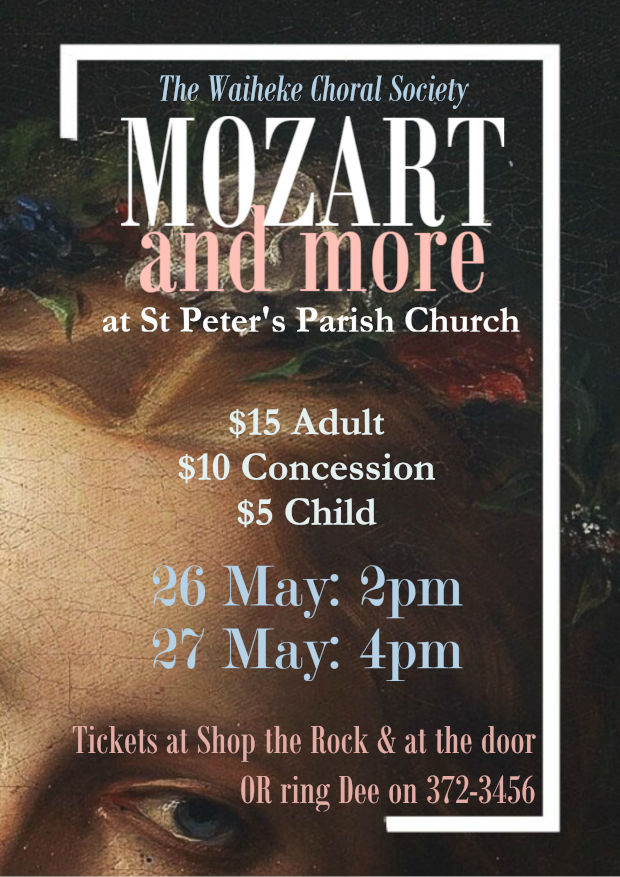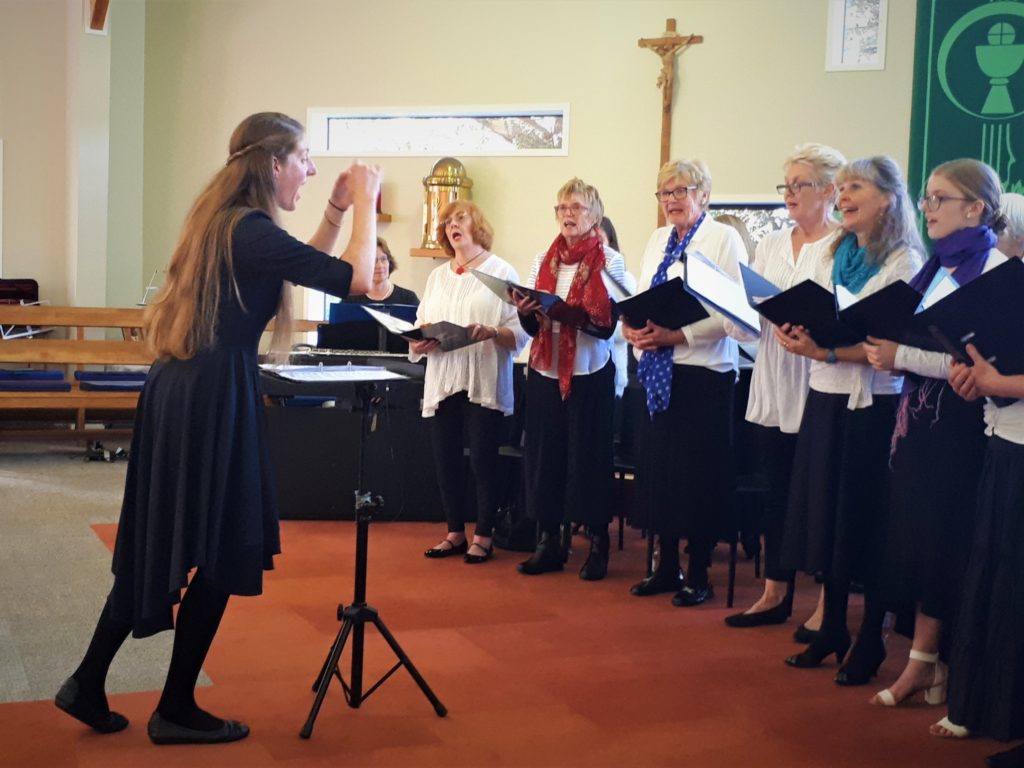Waiheke Island Choral Society
P O Box 333, Oneroa, Waiheke Island 1840, New Zealand

Waiheke Island Choral SocietyP O Box 333, Oneroa, Waiheke Island 1840, New Zealand |  |

|
|
Listen to Waiheke Radio’s recording |
Mozart’s Requiem in D minor
Most requiems are sad, contemplative affairs, full of melancholy over the loss of loved ones and prayers for their eternal rest. In Mozart’s Requiem in D minor, this quiet, pensive mood lasts for all of twenty-four seconds before giving way to the composer’s terror in the face of death.
Mozart wrote his Requiem in 1791, the last year of his short life. It was commissioned by Count Franz von Walsegg, but Mozart’s widow Constanze later recounted her husband’s hallucinations that he was writing the music for his own funeral. The Introitus, Dies irae, and Confutatis movements feature menacing bass and tenor lines dealing with death and damnation, alternating with lilting soprano and alto prayers. The Kyrie movement, a plea to the Lord for mercy, takes on a frantic quality and ends in a desperate, almost demanding tone. Only the Lacrimosa movement returns to the subject of tears for the departed.
The composition of the Requiem was fictionalised in the 1979 play Amadeus, adapted to film in 1984. The story line held that Mozart had no idea who had commissioned the work, and that rival composer Antonio Salieri was behind the commission, intending to pass the Requiem off as his own work after Mozart’s death — a death which Salieri was keen to hurry along. In reality Constanze, at least, knew exactly who had commissioned the work, since she presented Count von Walsegg with the bill. It is quite possible that von Walsegg himself intended to steal the Requiem, a trick that he is known to have played on other composers.
Mozart never completed the Requiem in D minor; after his death, Constanze arranged with Mozart’s student Franz Xaver Süssmayr to finish the work, presumably using notes left by Mozart. Musicologists have argued ever since just how much of the Requiem is really Mozart’s. The five movements being presented today are known to have been substantially written by Mozart himself.
Concert Programme
(Wolfgang Amadeus Mozart)
Ave verum corpus
Requiem in D minor:
• Introitus (with solo by Saskia)
• Kyrie (ensemble)
• Dies irae
• Confutatis (ensemble)
• Lacrimosa
Nocturnes:
• Luci care, luci belle
• Se lontan ben miu tu (ensemble)
• Due pupille amabili
• Più non si trovano (ensemble)
Soave sia il vento (Cosí Fan Tutte: Andy, Maya & Saskia with Rosemary on piano)
Andante in C major for flute and piano (Ariane and Rosemary)
Polonaise (L Mozart, arranged by Henry O Millsby)
Bourée (L Mozart, arranged by Henry O Millsby)
Waiheke Choral Society
| Musical Director: | Ariane Duclos |
| Piano: | Carolyn Smart Rosemary Adler |
| Clarinet: | Janneke Visser Willi Willmann |
| Flute: | Ariane Duclos |
| Violin: | Ben Cobbett |
| Ensemble: | Andy Spence (T), Ann Jocelyn (A), Dee Austring (A), Mark James (T), Maya Spence (S), Nicolas Herren (B), Peter Forster (B), Rosemary Adler (S), Saskia Herren (S)
|
| Committee: | Saskia Herren (President), Mark James (Treasurer), Susan Triggs (Secretary), Andy Spence, Gavin Smart, Maya Spence, Nicolas Herren
|
Choir Members:
Sopranos:
| Frances Salt | Janet Mayes | |
| Mary Batten | Maya Spence | |
| Nika Dyblenko | Norma Cross | |
| Pam Manktelow | Rosemary Adler | |
| Sandra Alley | Saskia Herren | |
| Susan Triggs |
Altos:
| Ann Jocelyn | Christine Beardon | |
| Dee Austring | Eileen Boghurst | |
| Elizabeth Haylock | Erica Hailstone | |
| Gillian Reeve | Hiromi Stewart | |
| Jeanne Mellamphy | Kara Nelson | |
| Kayla Mackenzie-Kopp | Kyrie Rose | |
| Liz Watts | Sophie Zaczek |
Tenors:
| Gavin Smart | Helga Meyer | |
| Jane Griffith | Joan Kirk | |
| Mark James | Shona McIvor |
Basses:
| Andy Spence | Nicolas Herren | |
| Peter Forster | Trevor Hynds |

Ariane Duclos conducts the Waiheke Island Choral Society. Photo: Chris Walker